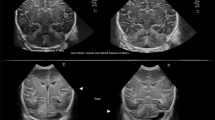Abstract
Posterior fossa lesions are rare. Introduction of high resolution ultrasound with 3D reconstruction and endovaginal evaluation of fetal brain through the fontanelle helps in better understanding of neuroanatomy. MRI is often used as an additional tool for evaluation in addition to ultrasound studies. Major components of posterior fossa such as cerebellar hemispheres, vermis, fourth ventricle, cisterna magna, and their normal variants and abnormalities can be demystified by ultrasound studies. Morphometry of these structures helps in the diagnoses of these abnormalities.















Similar content being viewed by others
References
Bolduc ME, Limperopoulos C. Neurodevelopmental outcomes in children with cerebellar malformations: a systematic review. Dev Med Child Neurol. 2009;51:256–67.
Malinger G, Monteagudo A, Pilu GL, Timor-Tritsch I, Toi A. Sonographic examination of the fetal central nervous system guidelines for performing the basic examination and the Fetal neurosonraphy. Ultrasound Obstet Gynecol. 2007;29:109–16.
Vinals F, Munoz M, Naveas R, Shalper J, Giuliano A. The fetal cerebellar vermis: anatomy and biometric assessment using volume contrast imaging in the C plane (VCI-C). Ultrasound Obstet Gynecol. 2005;26:622–7.
Contro E, Volpe P, De Musso F, Muto B, Ghi T, De Robertis V, Pilu G. Open fourth ventricle prior to 20 weeks gestation : a benign finding? Ultrasound Obstet Gynecol. 2014;43:154–8.
Robinson AJ, Goldstein R. The cisterna magna septa: vestigial remnants of Blake’s pouch and a potential new marker for normal development of the rhombencephalon. J Ultrasound Med. 2007;26:83–95.
Bernard JP, Moscoso G, Renier D, Ville Y. Cystic malformation of the posterior fossa. Prenat Diagn. 2001;21:1064–9.
Bertucci E, Gindes L, Mazza V, Re C, Lerner-Geva L, Achiron R. Vermian biometric parameters in the normal and abnormal fetal posterior fossa three-dimensional sonographic study. JUM. 2011;30(10):1403–10.
Keogan MT, DeAtkine AB, Hertzberg BS. Cerebellar vermian defects: antenatal sonographic appearance and clinical significance. J Ultrasound Med. 1994;13(8):607–11.
Pilu G, Goldstein I, Reece EA, Perolo A, Foschini MP, Hobbins JC, Bovicelli L. Sonography of fetal Dandy–Walker malformation: a reappraisal. Ultrasound Obstet Gynecol. 1992;2(3):151–7.
McAuliffe F, Chitayat D, Halliday W, Keating S, Shah V, Fink M, Nevo O, Ryan G, Shannon P, Blaser S. Rhombencephalosynapsis: prenatal imaging and autopsy findings. Ultrasound Obstet Gynecol. 2008;31(5):542–8.
Achiron R, Achiron A. Transvaginal ultrasonic assessment of the early fetal brain. Ultrasound Obstet Gynecol. 1991;1(5):336–44.
Egle D, Strobl I, Weiskopf-schwendinger V, Grubinger E, Kraxner F, Mutz-Dehbalaie IS, Strasak A, Scheier M. Appearance of the fetal posterior fossa at 11 + 3 to 13 + 6 gestational weeks on transabdominal ultrasound examination. Ultrasound Obstet Gynecol. 2011;38:620–4.
Bornstein E, Rodríguez JLG, Pavón ECÁ, Quiroga H, Or D, Divon MY. First-trimester sonographic findings associated with a Dandy–Walker malformation and Inferior vermian hypoplasia. J Ultrasound Med. 2013;32:1863–8.
Gandolfi Colleoni G, Contro E, Carletti A, Ghi T, Campobasso G, Rembouskos G, Volpe G, Pilu G, Volpe P. Prenatal diagnosis and outcome of fetal posterior fossa fluid collections. Ultrasound Obstet Gynecol. 2012;39(6):625–31.
Author information
Authors and Affiliations
Corresponding author
Ethics declarations
Conflict of interest
None.
Rights and permissions
About this article
Cite this article
Praveen, T.L.N., Surekha, P. Demystifying Posterior Cranial Fossa Lesions in the Fetus. J. Fetal Med. 3, 63–69 (2016). https://doi.org/10.1007/s40556-016-0092-0
Received:
Accepted:
Published:
Issue Date:
DOI: https://doi.org/10.1007/s40556-016-0092-0




